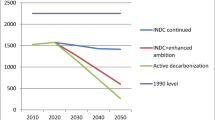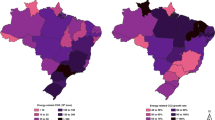Abstract
Brazil’s economic development has been underpinned by a diverse and – in a global comparison – unusual set of energy carriers, notably hydroelectricity and ethanol from sugar cane. Its energy mix makes Brazil one of the least energy-related carbon-intensive economies worldwide. Given that the country is fast becoming one of the world’s economic powerhouses, decision-makers need to understand the drivers underlying past and current carbon dioxide emissions trends. We therefore investigate a) which key long-term drivers have led to Brazil’s unique emissions profile, and b) the implications of these drivers for Brazil’s national policies. We show that Brazil’s emissions are growing mainly due to increasing individual standards of living, exports and population size, and that this growth is so far unchallenged by technological and structural improvements toward lower emissions intensities and more efficient production structures. As these trends are likely to continue amidst growing international pressure on key economies to reduce their carbon emissions, a decoupling of drivers from emissions is needed to simultaneously meet development and environmental goals.



Similar content being viewed by others
References
Aguiar A, Ometto J, Nobre C, Lapola D, Almeida C, Vieira I, Soares J, Alvala R, Saatchi S, Valeriano D, Castilla-Rubio J (2012) Modeling the spatial and temporal heterogeneity of deforestation-driven carbon emissions: the INPE-EM framework applied to the Brazilian Amazon. Global Change Biol. doi:10.1111/j.1365-2486.2012.02782.x
Baer W, da Fonseca MAR, Guilhoto JJM (1987) Structural changes in Brazil’s industrial economy, 1960–1990. World Dev 14:275–286
Barona E, Ramankutty N, Hyman G, Coomes OT (2010) The role of pasture and soybean in deforestation of the Brazilian Amazon. Environ Res Lett 5:024002
Beekman V (2001) A green third way? Philosophical reflections on government interventions in non-sustainable lifestyles. PhD Thesis, Wageningen UR, Internet site http://library.wur.nl/WebQuery/wda/lang?dissertatie/nummer=2942, Wageningen, Netherlands.
Borba BSMC, Lucena AFP, Rathmann R, Costa IVL, Nogueira LPP, Rochedo PRR, Castelo Branco DA, Júnior MFH, Szklo A, Schaeffer R (2012) Energy-related climate change mitigation in Brazil: Potential, abatement costs and associated policies. Energy Policy
Cederberg C, Persson UM, Neovius K, Molander S, Clift R (2011) Including carbon emissions from deforestation in the carbon footprint of Brazilian beef. Environ Sci Technol 45:1773–1779
Cleveland CJ (2003) Biophysical constraints to economic growth. In: Al Gobaisi D (ed) Encyclopedia of life support systems. EOLSS Publishers Co., Oxford
Cohen CAMJ, Lenzen M, Schaeffer R (2005) Energy requirements of households in Brazil. Energy Policy 55:555–562
de Azevedo TR (2012) Estimativas de emissões de gases de efeito estufa no Brasil 1990–201. Serviço Florestal Brasileiro do Ministério do Meio Ambiente, unpublished manuscript, Brasília, Brazil
de Gouvello C, Soares Filho BS, Nassar A, Schaeffer R, Alves FJ, Alves JWS (2010) Brazil low-carbon: country case study. The World Bank, Washington
Duro JA, Padilla E (2006) International inequalities in per capita CO2 emissions: a decomposition methodology by kaya factors. Energy Econ 28:170–187
EPE (2011) Balanço Energético Nacional 2010 - Matrizes consolidadas. Empresa de Pesquisa Energética, Ministéria de Minas e Energia, Governo Federal
FBDS (2009) Carta Aberta ao Exmo. Sr. Presidente da República. Fundação Brasileira para o Desenvolvimento Sustentável, Rio de Janeiro, Brazil
Fearnside P (1986) Spatial concentration of deforestation in the Brazilian Amazon. Ambio 15:72–79
Goldsmith PD (2008) Economics of soybean production, marketing, and utilization. Soybeans: chemistry, production, processing and utilization. AOCS Press, Champaign, pp 117–150
Henriques MF Jr, Schaeffer R, Dantas F (2010) Potential for reduction of CO2 emissions and a low-carbon scenario for the Brazilian industrial sector. Energy Policy 38:1946–1961
Hertwich EG (2010) The life-cycle environmental impacts of consumption. Econ Syst Res 23:27–47
IBGE (2008) Population Projection of Brazil. Instituto Brasileiro de Geografia e Estatística, Ministério de Planejamento e Orçamento, Rio de Janeiro, Brazil
IBGE (2011) População e Distribuição da população nos Censos Demográficos. Instituto Brasileiro de Geografia e Estatística, Ministério de Planejamento e Orçamento, Rio de Janeiro, Brazil
IEA (2011) CO2 emissions from fuel combustion. IEA/OECD, Paris
INPE (2012) Brazil’s National Institute for Space Research
IPEA (2010) PIB (preços 2009). Instituto de Pesquisa Econômica Aplicada, Brasília, Distrito Federal, Brazil
Lenzen M, Wier M, Cohen C, Hayami H, Pachauri S, Schaeffer R (2006) A comparative multivariate analysis of household energy requirements in Australia, Brazil, Denmark, India and Japan. Energy 31:181–207
Licker R, Johnston M, Foley JA, Barford C, Kucharik CJ, Monfreda C, Ramankutty N (2010) Mind the gap: how do climate and agricultural management explain the ‘yield gap’ of croplands around the world? Glob Ecol Biogeogr 19:769–782
MDICE (2012) Inovar Auto. Ministério do Desenvolvimento, Indústria e Comércio Exterior, Brasília, Brazil
Minx J, Wiedmann T, Wood R, Peters GP, Lenzen M, Owen A, Scott K, Barrett J, Hubacek K, Baiocchi G, Paul A, Dawkins E, Briggs J, Guan D, Suh S, Ackerman F (2009) Input–output analysis and carbon footprinting: an overview of applications. Econ Syst Res 21:187–216
MME/EPE (2012) Plano Decenal de Expansão de Energia 2021. Ministério de Minas e Energia. Empresa de Pesquisa Energética, Brasília
Muylaert de Araújo MS, Pires de Campos C, Rosa LP (2007) GHG historical contribution by sectors, sustainable development and equity. Renew Sust Energ Rev 11:988–997
Nepstad DC, Stickler CM, Almeida OT (2006) Globalization of the Amazon soy and beef industries: opportunities for conservation. Conserv Biol 20:1595–1603
Petrobras (2013) Plano de Negocios 2013–2017
Rathmann R, Schaeffer R, Szklo A (2012) Targets and results of the Brazilian Biodiesel Incentive Program: Has it reached the Promised Land? Applied Energy 97
Raupach MR, Marland G, Ciais P, Le Quéré C, Canadell JG, Klepper G, Field CB (2007) Global and regional drivers of accelerating CO2 emissions. Proc Natl Acad Sci 104:10288–10293
Silva EF (2012) Rio + 20 and Brazil’s policy on climate change. Nat Clim Chang 2:379–380
Trading Economics (2012) Air transport; passengers carried in Brazil
Trainer FE (1997) Can renewable energy sources sustain affluent society? Energy Policy 23:1009–1026
Trainer T (2010) Can renewables etc. solve the greenhouse problem? The negative case. Energy Policy 38:4107–4114
UNFCCC (2012) Appendix II - Nationally appropriate mitigation actions of developing country Parties - Brazil. United Nations Framework Convention on Climate Change. Bonn, Germany
UNFCCC (2013) Non-Annex I national communications. United Nations Framework Convention on Climate Change
Valdes C, Vidigal Lopes I, de Rezende Lopes M (2009) Brazil’s changing food demand challenges the farm sector. Choices 24:52–56
Whitmarsh L, Seyfang G, O’Neill S (2011) Public engagement with carbon and climate change: to what extent is the public 'carbon capable’? Glob Environ Chang 21:56–65
Wiedmann T (2009) Editorial: carbon footprint and input–output analysis: an introduction. Econ Syst Res 21:175–186
Acknowledgments
This research was partly funded by the Norwegian Research Council project “Quantifying the global socio-economic and policy drivers for Brazil’s contribution to global warming” (196090), and partly by the Australian Research Council through its Discovery Project DP0985522 and its Linkage Project LP0669290. Regis Rathmann provided information on statistical revisions of the Brazilian input–output tables.
Author information
Authors and Affiliations
Corresponding author
Rights and permissions
About this article
Cite this article
Lenzen, M., Schaeffer, R., Karstensen, J. et al. Drivers of change in Brazil’s carbon dioxide emissions. Climatic Change 121, 815–824 (2013). https://doi.org/10.1007/s10584-013-0930-1
Received:
Accepted:
Published:
Issue Date:
DOI: https://doi.org/10.1007/s10584-013-0930-1




